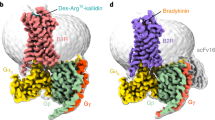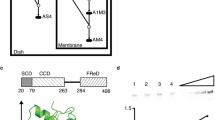Abstract
Introduction
Carboxypeptidase M (CPM) is a glycosylphosphatidylinositol anchored enzyme that plays an important role in the kallikrein–kinin system (KKS). CPM catalytic domain hydrolyzes Arg from C-terminal peptides (i.e., bradykinin and kallidin), generating des-Arg-kinins, the agonists of B1 receptor (B1R). It is known that CPM and kinin B1R are co-localized in the plasma membrane microdomains, where they interact with each other, facilitating receptor signaling.
Aims
We hypothesized here that this CPM-B1R interaction could also affect the activity of the enzyme.
Methods
Thus, in this work, we evaluated the impact of B1R presence or absence on CPM activity and expression, using primary culture of microvascular endothelial cells from wild-type, kinin B1R knockout mice (B −/−1 ), and transgenic rats overexpressing B1 receptor exclusively in the endothelium. In addition, HEK293T cells, as wells as B −/−1 primary culture of endothelial cells, both transfected with B1R, were also used.
Results
CPM expression and activity were downregulated in cells of knockout mice compared to control and this reduction was rescued after B1R transfection. Cells overexpressing B1R presented higher levels of CPM mRNA, protein, and activity. This profile was reverted by pre-incubation with the B1R antagonist, R715, in highly expressing receptor cells.
Conclusions
Our data show that kinin B1R positively modulates both CPM expression and activity, suggesting that CPM-B1R interaction in membrane microdomains might affect enzyme activity, beyond interfering in receptors signaling. This work highlights the interactions among different components of KKS and contributes to a better understanding of its patho-physiological role.






Similar content being viewed by others
References
Inder KL, Davis M, Hill MM. Ripples in the pond—using a systems approach to decipher the cellular functions of membrane microdomains. Mol BioSyst. 2013;9(3):330–8.
Rossy J, Ma Y, Gaus K. The organisation of the cell membrane: do proteins rule lipids? Curr Opin Chem Biol. 2014;20C:54–9.
Bissig C, Gruenberg J. Lipid sorting and multivesicular endosome biogenesis. Cold Spring Harb Perspect Biol. 2013;5:a016816.
Simons K, Ikonen E. Functional rafts in cell membranes. Nature. 1987;387:569–72.
Mukherjee S, Maxfield FR. Membrane domains. Annu Rev Cell Dev Biol. 2004;20:839–66.
Simons K, Toomre D. Lipid rafts and signal transduction. Nat Rev Mol Cell Biol. 2000;1(1):31–9.
Smart EJ, Graf GA, McNiven MA, Sessa WC, Engelman JA, Scherer PE, Okamoto T, Lisanti MP. Caveolins, liquid-ordered domains, and signal transduction. Mol Cell Biol. 1999;19:7289–304.
Zhang X, Skidgel R. Carboxypeptidase M. Handbook of proteolytic enzyme. 3rd ed. Oxford: Academic Press; 2013. p. 1357–66.
Deiteren K, Hendriks D, Scharpé S, Lambeir AM. Carboxypeptidase M multiple alliances and unknown partners. Clin Chim Acta. 2009;399:24–39.
Skidgel RA. Basic carboxypeptidases: regulators of peptide hormone activity. Trends Pharmacol Sci. 1988;9:299–304.
Reverter D, Maskos K, Tan F, Skidgel RA, Bode W. Crystal structure of human carboxypeptidase M, a membrane-bound enzyme that regulates peptide hormone activity. J Mol Biol. 2004;338(2):257–69.
Goding JW, Howard MC. Ecto-enzymes of lymphoid cells. Immunol Rev. 1998;161:5–10.
Skidgel RA, Davis RM, Tan F. Human carboxypeptidase M: purification and characterization of a membrane-bound carboxypeptidase that cleaves peptide hormones. J Biol Chem. 1989;264:2236–41.
Tan F, Balsitis S, Black JK, Blöchl A, Mao JF, Becker RP, Schacht D, Skidgel RA. Effect of mutation of two critical glutamic acid residues on the activity and stability of human carboxypeptidase M and characterization of its signal for glycosylphosphatidylinositol anchoring. Biochem J. 2003;370(Pt 2):567–78.
Zhang X, Tan F, Brovkovych V, Zhang Y, Skidgel RA. Cross-talk between carboxypeptidase M and the kinin B1 receptor mediates a new mode of G protein-coupled receptor signaling. J Biol Chem. 2011;286:18547–61.
Denis CJ, Lambeir AM. The potential of carboxypeptidase M as a therapeutic target in cancer. Expert Opin Ther Targets. 2013;17(3):265–79.
Hadkar V, Sangsree S, Vogel SM, Brovkovych V, Skidgel RA. Carboxypeptidase-mediated enhancement of nitric oxide production in rat lungs and microvascular endothelial cells. Am J Physiol Lung Cell Mol Physiol. 2004;287:L35–45.
Vroling B, Sanders M, Baakman C, Borrmann A, Verhoeven S, Klomp J, Oliveira L, de Vlieg J, Vriend G. GPCRDB: information system for G protein-coupled receptors. Nucleic Acids Res. 2011;39:D309–19.
Leeb-Lundberg LM, Marceau F, Muller-Esterl W, Pettibone DJ, Zuraw BL. International union of pharmacology. XLV. Classification of the kinin receptor family: from molecular mechanisms to pathophysiological consequences. Pharmacol Rev. 2005;57:27–77.
Mombouli JV, Vanhoutte PM. Kinins and endothelial control of vascular smooth muscle. Annu Rev Pharmacol Toxicol. 1995;35:679–705.
Field JL, Butt SK, Morton IK, Hall JM. Bradykinin B2 receptors and coupling mechanisms in the smooth muscle of the guinea-pig taenia caeci. Br J Pharmacol. 1994;113(2):607–13.
Oliveira L, Paiva AC, Sander C, Vriend G. A common step for signal transduction in G protein-coupled receptors. Trends Pharmacol Sci. 1994;15(6):170–2.
Marceau F. Kinin B1 receptors: a review. Immunopharmacology. 1995;30:1–26.
Steranka LR, Manning DC, DeHaas CJ, Ferkany JW, Borosky SA, Connor JR, Vavrek RJ, Stewart JM, Snyder SH. Bradykinin as a pain mediator: receptors are localized to sensory neurons, and antagonists have analgesic actions. PNAS. 1988;85(9):3245–9.
Marceau F, Bachvarov DR. Kinin receptors. Clin Rev Allergy Immunol. 1998;16(4):385–401.
Leeb-Lundberg LM, Kang DS, Lamb ME, Fathy DB. The human B1 bradykinin receptor exhibits high ligand-independent, constitutive activity. Roles of residues in the fourth intracellular and third transmembrane domains. J Biol Chem. 2001;276(12):8785–92.
Faussner A, Bathon JM, Proud D. Comparison of the responses of B1 and B2 kinin receptors to agonist stimulation. Immunopharmacology. 1999;45(1–3):13–20.
Kang DS, Gustafsson C, Mörgelin M, Leeb-Lundberg LM. B1 bradykinin receptor homo-oligomers in receptor cell surface expression and signaling: effects of receptor fragments. Mol Pharmacol. 2005;67(1):309–18.
Zhang X, Tan F, Zhang Y, Skidgel RA. Carboxypeptidase M and kinin B1 receptors interact to facilitate efficient B1 signaling from B2 agonists. J Biol Chem. 2008;283(12):7994–8000.
Zhang Y, Brovkovych V, Brovkovych S, Tan F, Lee BS, Sharma T, Skidgel RA. Dynamic receptor-dependent activation of inducible nitric-oxide synthase by ERK-mediated phosphorylation of Ser745. J Biol Chem. 2007;282(44):32453–61.
Marcic B, Deddish PA, Jackman HL, Erdos EG, Tan F. Effects of the N-terminal sequence of ACE on the properties of its C-domain. Hypertension. 2000;36:116–21.
Chen Z, Deddish PA, Minshall RD, Becker RP, Erdös EG, Tan F. Human ACE and bradykinin B2 receptors form a complex at the plasma membrane. FASEB J. 2006;20(13):2261–70.
Erdös EG, Deddish PA. The kinin system: suggestions to broaden some prevailing concepts. Int Immunopharmacol. 2002;2(13–14):1741–6.
Sabatini RA, Guimarães PB, Fernandes L, et al. ACE activity is modulated by kinin B2 receptor. Hypertension. 2008;51(3):689–95.
Pesquero JB, Araujo RC, Heppenstall PA, Stucky CL, Silva JA Jr, Walther T, Oliveira SM, Pesquero JL, Paiva AC, Calixto JB, Lewin GR, Bader M. Hypoalgesia and altered inflammatory responses in mice lacking kinin B1 receptors. PNAS. 2000;97(14):8140–5.
Merino VF, Todiras M, Campos LA, Saul V, Popova E, Baltatu OC, Pesquero JB, Bader M. Increased susceptibility to endotoxic shock in transgenic rats with endothelial overexpression of kinin B(1) receptors. J Mol Med. 2008;86(7):791–8.
Chen SF, Fei X, Li SH. A new simple method for isolation of microvascular endothelial cells avoiding both chemical and mechanical injuries. Microvasc Res. 1995;50:119–28.
Livak KJ, Schmittgen TD. Analysis of relative gene expression data using real-time quantitative PCR and the 2(-Delta Delta C(T)) method. Methods. 2001;25(4):402–8.
Laemmli UK. Cleavage of structural proteins during the assembly of the head of bacteriophage T4. Nature. 1970;227:680–5.
Bradford MM. A rapid and sensitive method for the quantitation of microgram quantities of protein utilizing the principle of protein-dye binding. Anal Biochem. 1976;72:248–54.
Bhoola KD, Figueroa C, Worthy K. Bioregulation of kinins: kallikreins, kininogens and kininases. Pharmacol. 1992;44:1–79.
Erdös EG, Skidgel RA. Metabolism of bradykinin by peptidases in health and disease. In: Farmer SG, editor. The Kinin system. London: Academic Press; 1997. p. 111–41.
Erdös EG. Kinins, the long march–a personal view. Cardiovasc Res. 2002;54(3):485–91.
Bouvier M. Oligomerization of G-protein-coupled transmitter receptors. Nat Rev Neurosci. 2001;2(4):274–86.
Devi LA. Heterodimerization of G-protein-coupled receptors: pharmacology, signaling and trafficking. Trends Pharmacol Sci. 2001;22(10):532–7.
Kang DS, Ryberg K, Mörgelin M, Leeb-Lundberg LM. Spontaneous formation of a proteolytic B1 and B2 bradykinin receptor complex with enhanced signaling capacity. J Biol Chem. 2004;279(21):22102–7.
Quitterer U, AbdAlla S. Vasopressor meets vasodepressor: the AT1-B2 receptor heterodimer. Biochem Pharmacol. 2014;88(3):284–90.
Abadir PM, Periasamy A, Carey RM, Siragy HM. Angiotensin II type 2 receptor-bradykinin B2 receptor functional heterodimerization. Hypertension. 2006;48(2):316–22.
AbdAlla S, Lother H, Quitterer U. AT1-receptor heterodimers show enhanced G-protein activation and altered receptor sequestration. Nature. 2000;407(6800):94–8.
Silva LS, Peruchetti DB, Silva CTF, Ferreira-DaSilva AT, Perales J, Caruso-Neves C, Pinheiro AAS. Interaction between bradykinin B2 and Ang-(1–7) Mas receptors regulates erythrocyte invasion by Plasmodium falciparum. Biochem Biophys Acta. 2016;1860(11PtA):2438–44.
Scott JD, Pawson T. Cell signaling in space and time: where proteins come together and when they’re apart. Science. 2009;326(5957):1220–4.
Eisener-Dorman AF, Lawrence DA, Bolivar VJ. Cautionary Insights on Knockout Mouse Studies: the Gene or Not the Gene? Brain Behav Immun. 2009;23(3):318–24.
Low MG. Glycosyl-phosphatidylinositol: a versatile anchor for cell surface proteins. FASEB J. 1989;3(5):1600–8.
Skidgel RA. Structure and function of mammalian zinc carboxypeptidases. Zinc metalloproteases in health and disease. London: Taylor and Francis Ltd.; 1996. p. 241–83.
Sun X, Wiesner B, Lorenz D, Papsdorf G, Pankow K, Wang P, Dietrich N, Siems WE, Maul B. Interaction of angiotensin-converting enzyme (ACE) with membrane-bound carboxypeptidase M (CPM)—a new function of ACE. Biol Chem. 2008;389(12):1477–85.
Proud D, Kaplan AP. Kinin formation: mechanisms and role in inflammatory disorders. Annu Rev Immunol. 1988;6:49–83.
Acknowledgements
We thank Eduardo Spitti Resende for technical assistance.
Funding
This work was supported by grants from the São Paulo State Research Foundation—FAPESP (Grant Nos. 2014/03790-5 and 2014/27198-8) and research fellows from the Brazilian National Research Council (CNPq), Coordenação de Aperfeiçoamento de Pessoal de Nível Superior (CAPES) (Grant No. 374/12), and Deutsche Akademische Austauchdienst Probral.
Author information
Authors and Affiliations
Corresponding author
Ethics declarations
Conflict of interest
The authors declare that they have no conflict of interest.
Additional information
Responsible Editor: Mauro Teixeira.
Publisher's Note
Springer Nature remains neutral with regard to jurisdictional claims in published maps and institutional affiliations.
Rights and permissions
About this article
Cite this article
Guimarães, P.B., da Silva, R.F., Hoff, C.C. et al. Interactions between carboxypeptidase M and kinin B1 receptor in endothelial cells. Inflamm. Res. 68, 845–855 (2019). https://doi.org/10.1007/s00011-019-01264-6
Received:
Revised:
Accepted:
Published:
Issue Date:
DOI: https://doi.org/10.1007/s00011-019-01264-6




